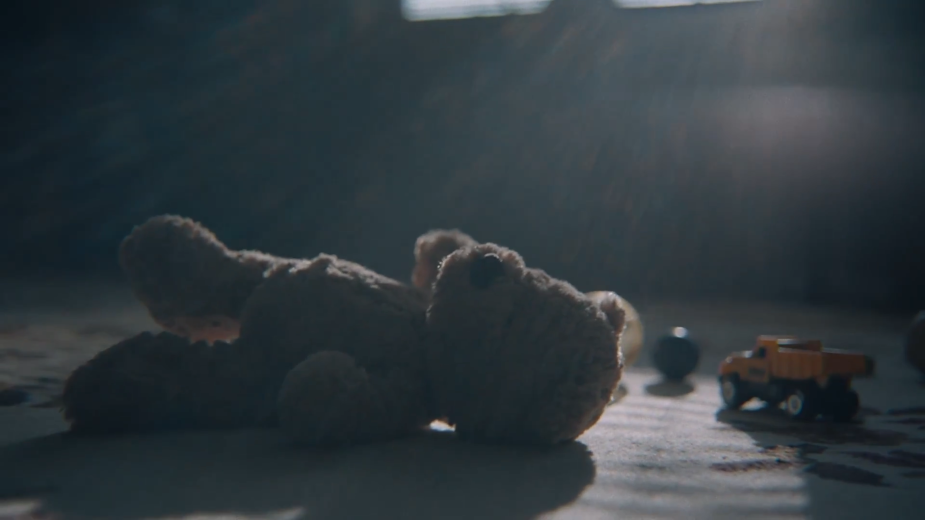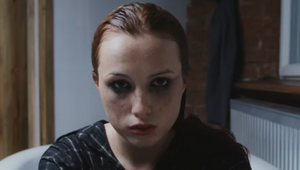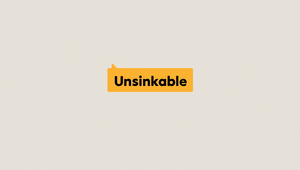
Why Gender-Based Violence Responders Are Needed

Did you know that two-thirds of people in Canada know a woman who has experienced physical, sexual, or emotional abuse? It’s an appalling statistic, made worse by the fact that only one in five Canadians actually feels confident in their ability to support someone experiencing abuse.
These figures, found by the Canadian Women’s Foundation (CWF), were all the reason needed to create a campaign speaking to abuse responders directly. Continuing the partnership with creative agency Juniper Park\TBWA, the two built upon the pre-existing ‘Signal for Help' platform with the release of ‘Change the Story’, a 60-second PSA highlighting the role of responders in addressing gender-based violence.
Playing heavily on the element of juxtaposition, the same story is told twice, with one featuring a reporter reflecting on how most gender-based violence stories unfold, and the other featuring a responder who, upon seeing something was off, reached out to offer non-judgemental support. It’s a powerful message - one which reminds viewers that anyone who knows how to recognise the signs of abuse has the power to change the story. And, to this end, viewers are driven here, where they can take the ‘Signal for Help’ online mini-course, subscribe, and learn more.
LBB’s Josh Neufeldt sat down with Juniper Park\TBWA president David Toto, CSO Des Jones, VP, director of planning Sohail Bhatia, executive creative director Neil Walker-Wells, and associate creative directors, Sasha Newton and Gira Moin, as well as CWF’s VP public engagement, Andrea Gunraj, senior director, public engagement Sarah Ruddle, and ‘Signal for Help’ manager Pam Di Pinto, to discuss how this work came to life.
LBB> What was the brief, and what immediate ideas came to mind?
CWF> Juniper Park\TBWA has been a great partner to us since the beginning of the ‘Signal for Help’ in 2020, working with us from the very start. For this latest effort, we want to reach many more people in Canada, ensuring they understand that the ‘Signal’ is not a theoretical or symbolic tool; when used and recognised in dangerous situations, women and girls get the help they need to get safe.
Beyond that, we want people to understand that when they take simple steps to be ‘Signal for Help’ responders - signing up at signalresponder.ca and applying the tips they learn - they absolutely can make a difference for someone dealing with intimate partner abuse, or any form of gender-based violence.
JP\TBWA> People are not always clear on the different shades of gender-based violence. So, the brief was to drive awareness of CWF’s online course which educates people as to what early signs of abuse look like. The purpose of the campaign was to highlight the importance of paying attention to the various signs and knowing how to respond when abuse is recognised.
There were a lot of ideas on the table at first – one specifically around ‘red flags’ and how often on social media, we talk and even poke fun at everyday red flags. However, the reality is that even seemingly insignificant red flags can be early signs of abuse - starting small and snowballing to worse and worse situations. That’s what drove us to focus the work on recognising even the small signs.
LBB> This campaign serves as an extension of the ‘Signal for Help’ platform. As such, what made a PSA the right creative approach for the job?
JP\TBWA> The ‘Signal for Help’ hand gesture is a powerful tool that can really help someone in a position where they can’t communicate. With that in mind, this year, we wanted to tackle the problem at its root, before it gets to the point where the hand gesture is needed. Hence, a PSA that dramatised how lives can be saved if you’re equipped and able to recognise when someone needs help.
CWF> The public knows about the terrible, tragic stories we see on the news about femicide and abuse. It happens all the time. We learn about them after something bad has happened, and by then it's too late. We mourn, but then we move on. We may not get the opportunity to think about what we could have done to prevent it from happening, or the steps we could have taken to support somebody at an earlier stage. In short, this is a missed opportunity.
The goal of the ‘Signal for Help’ responder effort is to help people recognise the opportunity and give people the confidence and competence to respond to any sign or signal of abuse. If we all took the steps to support survivors in our lives - our family, friends, and coworkers - gender-based violence wouldn't be nearly as common as it is. We believe it would become unacceptable behaviour that society doesn’t believe is inevitable, and that we know we can stop together.
LBB> Some shocking statistics are that 66% of Canadians know a woman who has experienced abuse, but only one in five feels very confident to provide support. Where did this insight come from, and how did it factor into the creative process?
JP\TBWA> The data came from first party research conducted by the CWF themselves, and was vital when developing the campaign platform, elements, and products. Through the information provided, we knew we had to address this hesitancy, specifically that people were concerned that they might get sucked into a complicated and very emotionally involved situation.
As a result, everything was made to feel as uncomplicated, yet impactful as possible - encouraging people to follow their conscience and not stress about the potential personal
consequences.
CWF> This information came from our 2022 national opinion poll. For me, what's more surprising than those statistics is the fact that 90% of people in Canada say gender-based violence is everybody's responsibility to prevent, but 23% also say ‘intimate partner violence is none of my business if it doesn't directly involve me’. We’re thrilled to know that so many people believe that we need to end gender-based violence, and we do believe that to be a massive cultural shift. However, there is also clearly a gap between our anti-violence beliefs, and our willingness and capacity to support a survivor in a situation of violence. This campaign is about closing that gap.

LBB> Gender-based violence is a critical topic to discuss. As such, how did you approach the creative in a sensitive yet meaningful way, and what made the juxtaposed storylines the best approach for the job?
JP\TBWA> It was important to walk the line between being authentic and sensitive to the types of stories that are out there. Not all abuse stories are gratuitously violent all the time - even if they end that way - which was important for the client to convey.
Too often, these types of PSAs are overtly violent, intense, or just plain sad, which leaves viewers feeling helpless and tuned out rather than hopeful and empowered. Moreover, the signs aren’t always that obvious. By using the device of two stories told at the same time, we were able to soften the blow of harsh realities, pairing it with the optimistic side of the same situation and demonstrating that the difference between a good ending and a bad one is quite subtle… Not sensational.
In terms of scenarios, a news coverage story made an appropriate outlet to tell a sad truth in its most authentic form, and the responder retelling a jarring story to a friend over FaceTime also felt natural. You never see the responder in action, she’s simply rehashing the story to a friend. Similarly, on the news broadcast, the crime is not re-enacted - it’s simply reported on. Both sides created a balance that didn’t shame or disturb the viewer, but also didn’t compromise the seriousness of the topic.
LBB> Who directed the spot, and what made them the perfect choice for the job?
JP\TBWA> A long-time creative director herself, we were pleased to work with Christina Yu on this project. She really understood the subtlety of the concept, and knew exactly how to bring the script to life.
LBB> Equally, the actors do an amazing job bringing the work to life. What was casting like, and as a whole, how was the shoot?
JP\TBWA> We were very lucky to have found two women who performed the roles based on personal experience. The news reporter was a real broadcaster with experience televising news, and our responder, sadly, had experience on the topic in some capacity in her life as well. They both performed their roles from the heart, and you can really feel it.
The shoot, though emotional at times, was one that you could really feel the love from. Often, PSAs have small budgets, and a lot of professionals cut their rates and volunteer their time. This was no different here - we had a great cast and crew who worked tirelessly to make the spot as beautiful and authentic as possible, and that type of selflessness is always memorable and special.


LBB> The background music is super ominous. How did you bring this aspect to life?
JP\TBWA> One of the benefits of working within a global collective like TBWA is that you get access to the entire collective of talent. For audio and sound design, we worked with the Emmy-awarded sound studio Sting, out of its Johannesburg office.
Specifically, we needed the sound design to bring two distinctly different worlds to life, while creating a pace that linked both narratives. The drive of the spot is intense, but the music was a beautiful way to transition the story to that of an optimistic, calm ending. We wanted the spot to be empowering and inspire viewers to become responders, without taking away from the tension.
LBB> And what was the editing process like? What did it take to weave the stories together in a memorable way?
JP\TBWA> There were a few different ways we considered editing this spot; split screen was a device we thought we would use throughout, but once we got into the guts of it all, we realised how powerful each performance was on its own. Cutting from one world to the other created a tension that really set the tone of cold, heartless chaos, versus calmness, humanity and warmth.
We also liked the misdirect of how the spot could be interpreted as one story with a sad outcome - flashing between the future and past, rather than two different stories with different endings. It made for richer entertainment value while adding an important layer of complexity.
LBB> What challenges have you faced during this project? How did you overcome them?
JP\TBWA> Budget is always a challenge with PSAs - that’s just a reality. No matter how many potential awards are on the horizon, how great an idea you have, or how important the cause is, money always becomes a hard conversation. That’s why it’s so important to recognise, thank and appreciate everyone who helped make this work. It’s truly a labour of love for the cause.
CWF> It's always hard to break through with a message that absolutely shatters misconceptions. The key misconception we continue to face is that abuse is uncommon or abnormal. Research shows us the opposite. Abuse is common, and prevention and intervention from everyday people and community-based sources like crisis lines and healthy relationship programs work. If we're going to get everybody eager and equipped to support survivors of abuse, we're going to have to do a lot of cultural shifting and retraining of our brains.
LBB> Do you have any memorable lessons learned from the making of this new campaign?
JP\TBWA> Recently, and especially with this client who puts a lot of trust in us; collaboration has become a beautiful thing. From our end, we left the interpretation of the script to the directors who pitched on the project, and didn’t spoon-feed them our vision. As such, the lesson here is when you allow work to be organic, and trust the process (from client, to creative, to production) magic happens.
CWF> We learned the value of taking the time to think things through slowly - ensuring we do it right. For example, it took us some time to remember to include a content note about gender-based violence at the beginning of the ‘Change the Story’ PSA. Content notes for depictions of abuse are common for us. We do it all the time to give people a heads-up. But, it's rare in advertising, and it's rare in commercials and PSAs. We had to take the time to remember to do that in this context.

LBB> Since release, what has the initial response been like?
JP\TBWA> Very positive. Anytime we put work out into the world, our first thought is ‘Did you get it?’. Not only have people loved the way the story unravels, but they really comprehend the importance of getting involved and how one person can truly make a difference in someone’s life story.
CWF> People have expressed to us how moved they are. There's something very real and very resonant about ‘Change the Story’, especially for those of us who know what it's like to support a friend, a neighbour, or a co-worker who’s in an abusive relationship. Most often, women and gender-diverse people are the ones supporting other women, and gender-diverse people are at the highest risk of facing gender-based violence. Think about it – a lot of fictional stories, movies, and books centre on men helping women escape abuse. Lots of stories focus on men’s reactions and vengeance against perpetrators of abuse. It's changing now, but that's what many of us grew up on. We appreciate how ‘Change the Story’ puts women’s and gender-diverse people’s real - and frankly common - experience in supporting survivors at the forefront.
LBB> Is there anything you’d like to add?
JP\TBWA> It’s not every day you get to work on something that literally saves lives. And in this case, we can say ‘LITERALLY’ without it being a colloquial term. It’s an incredible feeling – it makes the long hours, the stress, the negotiations, the revisions, the endless meetings etc., all worthwhile. If you haven’t, please do check out the mini online course at signalforhelpresponder.ca. There are people out there asking for help - we just need to hear them.
CWF> The Canadian Women's Foundation is Canada's public foundation for gender justice and equality. We're thrilled that the ‘Signal for Help’ has just won a Governor General’s Innovation Award. It's a simple innovation, and an effective one. If you want to support, sign up to become a ‘Signal for Help’. You'll get an action guide right away, and you'll start a simple digital learning journey with tips, tools, and interactive material to help you practice responding to signs and signals of abuse. It's all about learning how to empathise, putting survivor needs first, and understanding where people can go for help in their community. And please consider becoming a donor. This impact is the result of our caring donor community - the people who make everything possible.















